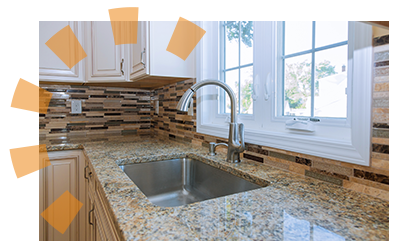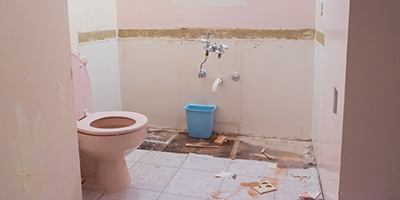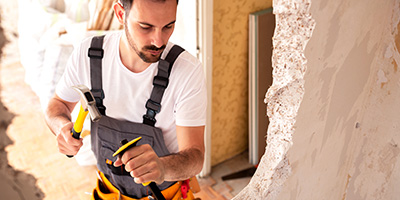Freshen Up Your Kitchen by Tearing Out Your Cabinets
Get your kitchen out of the 80s with new cabinetry. Learn how to tackle the upper and lower storage areas step-by-step.
Make cleanup a breeze with a roll off dumpster:

Your Step-By-Step Kitchen Cabinet Removal Guide
Are you looking to update your kitchen, but don’t have the time or budget for a full-on remodel? Luckily, there’s a simple way to give your kitchen a facelift without breaking the bank — remove and replace your cabinets.
While you might hire a professional to install new cabinets, removing them yourself is a simple task if you have the time to knock it out. All it takes is a little finesse with your pry bar and a few precautions to avoid damage to your countertops and floor. Click a step in the list below to jump to where you need help, or read on to start at the beginning.
Cabinet Removal FAQs
What tools do I need to remove cabinets?
The majority of the tools you need to remove cabinets are available in a standard toolbox:
- Pry bar
- Putty knives
- Utility knife
- Hammer
- Drill
- Screwdriver
- Wrench
- Reciprocating saw
Another handy item for your cabinet removal is a roll off dumpster. Removing cabinets creates a lot of debris, and getting those items removed quickly is important. With a roll off dumpster nearby, you can throw out your scrap woods, drawers and any other debris as you work.
Ready to get a dumpster? Place your order online today.
How hard is it to remove kitchen cabinets?
The process of removing cabinets is a beginner DIY project. It doesn’t require any special tools or equipment, isn't very time-consuming and requires minimal construction know-how. If you have a basic tool kit, an available weekend and are able to lift 20-30 pounds, you can handle this project with ease.
How much does kitchen cabinet removal cost?
If you opt to hire a professional, expect to pay between $645 - $1,370 for 25 linear feet of cabinets. For DIY cabinet removal, the cost tends to be as low as your debris disposal method, so renting a dumpster and doing the work yourself will often be a cheaper option.
How long does it take to remove kitchen cabinets?
The whole project can be completed in a few hours, depending on the number of cabinets that need removed and the materials you are working with. It’s best to give yourself a full day to complete the project in case any unexpected difficulties come up.
Order a Dumpster Online
Shopping after hours? Too busy to make another call? Book the dumpster you need, when you need it. Order your dumpster online 24/7.

How to Remove Cabinets From Your Kitchen Walls
The process of getting rid of cabinets isn’t tough in itself. If you have a free weekend and a basic toolkit, you’ll be good to go. Just remember that you'll be without cabinets until new ones are installed. So don't plan to tear them out without a solid storage plan in place for the contents if it's going to be a while before the new ones arrive.
Ready to get started? Read on to see what you need to begin the job.
Cabinet Removal Prep
Gather Tools
Most of the tools you need for cabinet removal are found in your basic toolbox. That’s a good thing, because it means you can get your project started whenever you’re ready without having to run to the home improvement store for special equipment.
This is also a good time to consider how you’re getting rid of the debris. If you’re saving the cabinets, make sure you have a space cleared to store them or a way to transport them to a donation center. If you’re tossing them, a 10 yard roll off dumpster is a convenient option that comfortably fits in most driveways.
Cabinet Removal Tools
Tools | Supplies |
|---|---|
Pry bar | Gloves |
Putty knives | Goggles |
Utility knife | Tarps |
Hammer | Spare 2x4s (for supporting needs) |
Drill | Step ladder |
Screwdriver | Measuring tape |
Wrench | |
Reciprocating saw |
Need a dumpster to handle the mess?
Get a Price and Place Your Order Give Us a Call to Learn More
Preparing the Area
It’s time to get started, but don’t jump right into demolition mode. There are a few things you need to do before the screws start coming out. These tasks aren’t hard, but they are important to a successful project and will help you keep the area clean and organized as you work:
- Empty out your cabinets.
- Clear everything from the countertops.
- Shut off utilities to the kitchen.
- Cover the floor and countertops with tarps.
Disassemble Cabinet Fixtures
It’s time to disassemble the cabinets. Start with anything that might move or get in the way when you start removing the body of the cabinets. This includes:
- Doors: Unscrew the bracket from the cabinet body so the hinge remains with the door.
- Shelves: Either unscrew the bracket from the cabinet body or simply lift the shelf from the support peg.
- Drawers: Pull the drawer all the way out, then lift and continue pulling. If that doesn’t work, you’ll need to detach the sliding bracket from the drawer. Be sure to label each drawer with a sticky note if you plan on reusing or donating the cabinets.
Take Off Trim and Seals
It’s time to remove the pieces of wood framing that join the cabinet with the floor or wall. The trim is typically decorative and does not contribute to the cabinet’s attachment. The most common things you’ll have to remove are molding, trim and caulk. Luckily, they are all pretty easy to get rid of.
- For caulk: Use a utility knife to sever the connection between the cabinet and other surfaces.
- For molding and trim: Use a hammer to wedge your pry bar behind the trim and pull it away.
While this might seem like a step you can skip, don’t. If you fail to remove these attachments now, you’ll be forced to do it later on when your cabinets are no longer affixed to the walls with screws, which is more dangerous.

Keep in Mind
If you’re trying to save the trim, be sure to work slowly and in smaller sections. However, if you want to keep the cabinets intact but something has to break, let the molding crack. It’s far cheaper to replace trim than a cabinet.
4 Steps to Remove Upper Cabinets
It’s officially time to get to the heavy work and remove the bare bones of the cabinets. So, get your hammer, drill and screwdriver, pick the left or the right end of your cabinets and get started.
1. Place Supports
Measure the space between your countertops and the bottom of your cabinets. Then, cut your 2x4 into four pieces matching the length. Place one of your cut supports under each corner of the cabinet you’re removing.
These supports aren’t intended to hold the cabinets in place forever. They are to help for a moment if your hand slips as you pull the cabinets off the wall.
Remember to ask someone for help if you need assistance with detaching your cabinets.


2. Detach Cabinets From Each Other
Not all cabinets will require this step since some might stand alone or simply do not connect. However, it’s a good idea to double-check to be safe.
Look at where your cabinet touches another one to see if there are any fasteners. Keep in mind that they may be covered for aesthetic reasons, so look for circular discolorations, stickers and other signs that a screw might be covered up. Also, only look on the sides on the cabinets — you won’t be removing any fasteners on the back until the next step.
Once you’ve located the screws, this step is as simple as unscrewing them.
3. Unfasten the Cabinet From the Wall
You’ll need to determine how your cabinets are attached to the wall to move forward with your project. There are two standard ways they are secured: screws and glue. Luckily, determining what type of cabinet you’re dealing with is as simple as looking. If you see screws, you need to remove them. If you don’t see screws, the cabinets are most likely glued.

How to Remove Cabinets Attached With Screws
Starting at the bottom, work your way to the top as you remove screws with a drill or screwdriver. Remember as you work on the final screws to support the cabinet so that it does not fall once detached.
Be sure to look on the bottom and top of the cabinet to ensure there are no screws attached to a hidden lip.
How to Remove Cabinets Glued to the Wall
Begin at the side of the cabinet and wedge your pry bar between the back of the cabinet and the wall. Do this in a couple of spots on the side to fully loosen the glue before repeating on the top and bottom of the cabinet. To minimize potential damage to the wall, use a stud finder and pry on top of any studs that may be behind the cabinet.
As you loosen the glue’s hold, be sure to keep a tight grip on the cabinet so that it does not fall.

4. Lift and Remove Cabinet
Once you believe you’ve fully detached the cabinet from the wall, gently lift the cabinet upwards and then pull it away from the wall. Be sure to do this step slowly in case there is any residual glue that has not come loose or you’ve missed a screw.
Once the cabinet is completely removed, clear it from your work zone so that you have plenty of space to remove the other cabinets.
4 Steps to Remove Lower Cabinets
While very similar to removing the upper cabinets, tearing out the lower ones requires a bit more effort and know-how, mostly because of the sink, dishwasher and countertops. Don’t worry — even with all of these extra obstructions, removing lower kitchen cabinets is still a pretty simple DIY task.
1. Lift Out the Kitchen Sink
Grab your wrench and utility knife and get started. In case you skipped the prep section, don't forget to shut off your utilities to the work area. Then, unhook all the pipes that lead to the sink. After that, use your utility knife to slice through any caulk attaching the sink to the cabinet or countertop. Finally, unscrew the sink and lift it out. Be sure to place it outside of your work zone.


2. Remove the Countertops
Your countertops will probably be attached to the cabinets with screws and caulk. Double-check this by looking at the bottom of the countertops. If that’s the case, simply unscrew the countertop and use a utility knife to cut the countertops away from the caulk. Then, simply lift it off the cabinets and move it out of the way. For more in-depth tips, check out our step-by-step countertop removal guide.
3. Detach Piping
This step is not needed for all kitchen cabinets, but might be necessary if a sink and dishwasher are not located next to each other. If so, the water pipes need to travel through a side cabinet wall to get to their destination.
You can detach the pipes in two ways depending on the type of cabinets you have. If your cabinets have no back panel, use your jigsaw to cut the side panel so that there is no wood between the pipe and the wall, which will allow you to slide the cabinet out around the pipe. If the cabinets have a back, you’ll need to use your wrench to detach the pipes and remove them.


4. Unfasten and Remove the Cabinets
All that’s left to do is remove the cabinets. Unscrew them from their neighboring cabinets and then detach them from the wall before pulling them out. For more in-depth directions, follow the instructions to remove upper cabinets.
You’re a Step Closer to Your New Kitchen
Your cabinets are gone, but what’s next? Will you replace them with a modern, sleek look or was this just a step in a larger kitchen renovation? Whatever's next, removing your cabinets was a big undertaking and helped push you toward your dream kitchen.
What Do You Think?
Planning a kitchen demo? We're listening. Head over to Twitter or Facebook,
and use #dumpstersblog to join the conversation.






